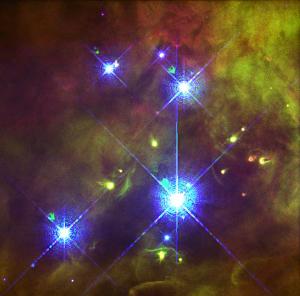Post
Four of a Kind
22 May 2013
One of the most popular constellations is Orion the hunter. In the sword of Orion, just below the belt is a nebula known as the Orion Nebula. This nebula is a stellar nursery about 1300 light years away. At the heart of the Orion Nebula is a small cluster of very bright stars known as the Trapezium Cluster. Because Trapezium is bright and reasonably close to us, we’re able to make very precise measurements of the stars’ speed and motion. What we find is a bit of a puzzle.
In a small telescope these look like four individual stars. These are formally known as Theta1 Orionis A, B, C, and D. Even under high resolution they look like single stars, as you can see in the Hubble image below. Under closer examination we find that C is a binary star, A is a triple star, and B is a quadruple system. So Trapezium is actually a cluster of multiple star systems.
 John Bally, Dave Devine, and Ralph Sutherland
John Bally, Dave Devine, and Ralph SutherlandThese stars all lie within 4 light years of each other, which is about the distance between the Sun and the next closest star (Proxima Centauri). Since the Orion nebula is a stellar nursery, it isn’t surprising that there are so many stars so close together. But when we measure the speed of these stars, we find they are moving quite quickly, which is very odd.
The Orion Nebula is about 3 million years old. Since the Trapezium cluster stars are quite large, they would have been among the first stars to form. Given their speeds, they have had plenty of time to fly apart from each other. This means one of either two things. Either they are flying apart, and they just happen to be close together right now, or they are gravitationally bound and are actually orbiting each other.
It’s pretty unlikely that four massive stars would all be within a few light years of each other, so it would seem more likely that they are gravitationally bound. But given their speeds, the stars don’t have enough mass to keep them together. If they are gravitationally bound, then there must be more mass than just the cluster itself holding the cluster together.
One idea is that there is a medium size black hole in the cluster. This black hole would have a mass of about 100 Suns, and would be hard to observe directly. Another suggestion is that the mass of the surrounding gas and dust clouds act to keep the cluster bound. Determining the gravitational effect of diffuse clouds on these stars is computationally intense, but it seems to allow the stars to be bound without introducing a black hole in the cluster.
I’m a bit biased toward the latter idea since I’ve worked a bit on that model. But it will take further observations to determine whether my hunch is right or not.